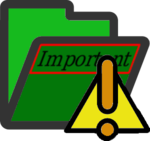If a CAEDM user needs extra disk space but does not need it for much time, the user can save files directly to the local machine. This is a very temporary option; those files will be deleted periodically. During a login session the files will be accessible, and protected, but may not be available after logging out and logging back in.
Other available options:
- Scratch Space allows groups access to virtually unlimited storage space, but this space is temporary and is not backed up. Files are not guaranteed to be preserved day to day. This option is good for storing large files for a few days (e.g. storing large data sets or images for a group for a short amount of time.)
- If temporary storage is not a solution, J Drive quota extensions are available if justified. Request by submitting this form. This option is optimal for individuals needing more permanent storage space.
Examples of correct usage of Storage resources
| Reason for needing more storage space. | Local Storage | Scratch Space | J Drive Quota Extention |
|---|---|---|---|
| Burning several DVD images to Disks | Store the Images to the Temp folders on the machines, then delete them when you're done. | Scratch space would also work, but using a network drive would take longer when handling such large files, using the local drive would be the best option. | This is a temporary need, the files will not be needed after burning the image, an extension would not be granted. |
| Storing intermediate files for FEA analysis | Files could be stored on a local machine, but since they may be needed for a few days over multiple logins from more than one machine, network scratch space makes more sense. | The Files would be safe in Scratch Space while running the processes, make sure to backup anything you want to keep when you're done. | They are temporary files, they do not need to be stored for long periods of time and can be recreated without great effort. An extension would not be justified. |
| Large CAD drawings for a senior project | It would be faster to edit these files if they were on a local machine, but for the sake of safety, they have to be stored in more permanent storage: the J Drive. | It is not worth taking the risk of losing classwork files to store them on scratch space, as it is not backed up. | This situation would substantiate a need of a J Drive quota extension. Submit the form to request a semester-long quota extension. |
Thin Clients
- Thin clients should not be used for temporary local storage. They do not have hard drives. They have extremely limited local storage and will not be able to handle large files.
RGS Windows
- Files can be placed on the RGS blades in the C:\temp folder. To access this folder type it into the address bar at the top of Windows Explorer. These files will be periodically erased, so they should be backed up at the end of each session. Once you log out of RGS, and log back in, your files may be gone.
Windows Media Stations
- Media stations are have a temporary file space as well on the D:\ drive in the Put_Your_Temp_Files_Here folder. This machine can hold a lot of temporary data, but, again, it is temporary, and it cannot be guaranteed that files stored there will remain there if you log out, and log back in.
Linux
- The Linux RGS Blades and the Linux lab machines also have a temporary folder available for use. The path of this folder is /tmp/. Like with Windows, this folder is purged periodically, but can be used as a source of fast temporary hard disk space. The files will be secure during the session, but after logging out and logging back in, the files may or may not be available.
Warning
- Remember that these options are temporary, no guarantees can me made concerning the longevity of these files. The purpose the temporary folders is simply to hold expendable files. Nothing important should be stored in temp folders! These folders are meant to be temporary, and though they may remain for some time, eventually they will be deleted.




